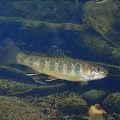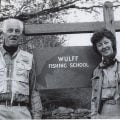How to Tie the Winter Parachute Midge
Producer: tightlinevideo
Every year that goes by, I gain more and more confidence in the color blue when it comes to winter flies. Here in New Jersey, we often get fairly substantial midge hatches from December through February and this blue Winter Parachute Midge really gets the job done.
The fly starts with a size 22 Dai-Riki #135 curved-shank hook, but it’s easily tied in even smaller sizes. Begin by getting the hook firmly secured in the jaws of your tying vise.
I then load a bobbin with a spool of UTC 70 Denier in a color called peacock blue. I’ve tried other shades of blue from different manufacturers and they seem to work as well. Get the thread started on the hook shank, leaving a full eye-length space behind the hook eye and, after taking a few rearward wraps, snip off the excess tag. While I’m in the bobbin-loading mood, I’ll load a second bobbin with a spool of white Veevus 16/0 thread, which will be used later for reinforcing the post and wrapping the parachute hackle.
Although not absolutely essential, I think this fly benefits from a small trailing shuck, so I’ll snip an inch-long segment of golden brown Antron yarn free from the spool. From this, pull off and dispose of about 1/4 to 1/3 of the fibers, as a full strand is just too much, then snip one end off square. Give your bobbin a good counterclockwise spin then place the snipped-off end on top of the hook shank. Take a thread wrap to begin securing the material then pull it under the wrap to shorten it. Continue taking thread wraps well down into the hook bend, binding the Antron to the top of the shank as you go. When you’re nearly at the vice jaws, start taking forward wraps back up the shank. Leave your tying thread hanging just rearward of the initial tie-in point. Snip the Antron off to leave a trailing shuck that’s about a hook gap in length.
White polypropylene floating yarn is used for the post of the fly. Snip a card-length free. Split that segment in half lengthwise, as only half the material will be used to create the post. Get hold of one end in the fingertips of your left hand and place it on top of the hook shank above your tying thread. Using a pinch wrap, begin securing the polypropylene to the top of the shank at about its midpoint. While maintaining your grip on the material, reach in with your tying scissors and snip the rearward-pointing portion off at a shallow angle. Take a few thread wraps over top of the snipped-off area, then advance your tying thread to in front of the wing.
Twist the yarn in a clockwise direction, as if you’re looking down on it, then fold it over on itself to create a furled post about a half inch in height. Anchor the material in front of the post with tight wraps of tying thread then reach in with your tying scissors and, using the hook eye as a guide, snip the excess off close. Ideally you’ll be able to cover up this snipped-off end with thread wraps and with no fibers blocking the hook eye. End with your tying thread immediately behind the post.
Now pick up the bobbin with the white thread and lay the end of the thread against the near side of the hook, then take thread wraps to lightly secure it. Pull the white thread under the wraps to its end. Continue taking rearward wraps with the blue tying thread all the way back to the base of the trailing shuck. Wrap forward to help fill in any low spots. Give your bobbin a counterclockwise spin to uncord and flatten the thread, then take wraps to smooth out the body of the fly. End with the blue thread immediately in front of the post. Pick up your whip finish tool and use it to anchor the thread with a 4 or 5 turn whip finish, then seat the knot well and snip or cut your tying thread free.
Next, give the bobbin with the white thread a really good clockwise spin to cord up that thread. Begin making open spiral wraps up the abdomen of the fly to give it a subtle look of segmentation. When you reach the wing post, take a few wraps around its base then end with your thread in front of the post.
Grizzly midge saddle hackle is used to hackle the fly. Once you find a feather with barbules that look to be about the right length, give it a check on a hackle gauge to make sure. Here, it shows them in the size 20 range, which is okay. Only when you’re sure of the size should you pluck the feather from the skin. At the lower end of the feather, preen the barbules perpendicular to the stem then begin stripping them off from both sides—this is with the shiny side of the feather facing you. Strip a few extra from the top edge of the stem to ensure the feather wraps correctly. You can then snip the feather, leaving about 1/8” of bare stem.
Still with the shiny side of the feather facing you, lay the bare stem at the base of the post on the near side of the fly and take thread wraps to secure it. Continue taking thread wraps up the post, binding the hackle stem to it as you go. Once you’re a good ways up, start taking wraps back down to the base and leave your thread hanging on the near side of the fly. Now, reorient the fly in your tying vise so the hook eye points down, like so.
Get hold of the feather and start taking touching wraps with it up the post, pushing up on the tying thread as you go. This will help to keep the hackle wraps sandwiched close together. After 3 or 4 turns, take wraps of tying thread around the post and over top of the hackle feather to secure it. You can then reach for some fine-point tying scissors and use them to snip the excess hackle tip off close. Next, pick up your whip finish tool and whip finish on the post above the hackle wraps. At this point, the post should be stiff enough to allow this to be done without any problems. Make sure to seat the knot really well before snipping or cutting your tying thread free. Reorient the fly in your tying vise back to its normal position.
If you need to, cut any extra hackle stem off as close as possible. Reach for some head cement, or here, Sally Hansen Hard as Nails, and apply a small drop to the thread wraps above the hackle to ensure they don’t come unraveled. The adhesive should also sink in and help to reinforce the post and the hackle wraps around it. Finally, snip the post off, leaving a small wing bud sticking out of the top.
This fly definitely has it all—a shiny, translucent trailing shuck, a slightly plump, lightly segmented blue body, a clear hook eye so the fly can be tied on with a delicate tippet, a nice little emergent wing which will also make the fly more visible on the water’s surface, hackle that curves downward to help the fly float on the surface film, and a super-clean underbody, the part of the fly most visible to trout. And that’s the winter parachute midge ready to fish. As small as these flies are, they really aren’t too troublesome to tie and deserve space in just about any winter fly angler’s fly box.
How to Tie the WD-40 Plus
How to Tie the Wood Special











